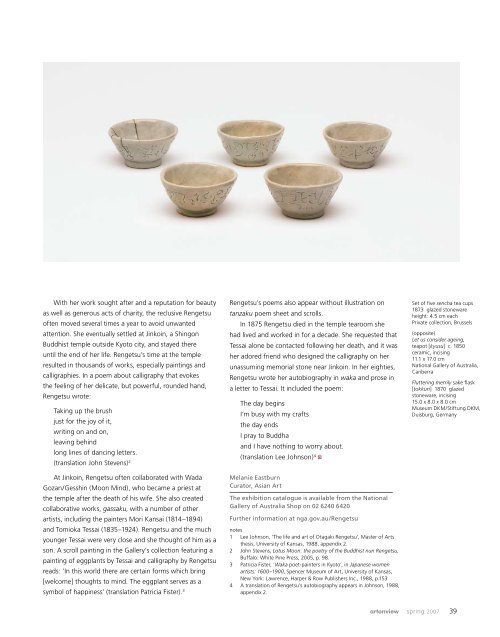Art Ew - National Gallery of Australia
Art Ew - National Gallery of Australia
Art Ew - National Gallery of Australia
You also want an ePaper? Increase the reach of your titles
YUMPU automatically turns print PDFs into web optimized ePapers that Google loves.
With her work sought after and a reputation for beauty<br />
as well as generous acts <strong>of</strong> charity, the reclusive Rengetsu<br />
<strong>of</strong>ten moved several times a year to avoid unwanted<br />
attention. She eventually settled at Jinkoin, a Shingon<br />
Buddhist temple outside Kyoto city, and stayed there<br />
until the end <strong>of</strong> her life. Rengetsu’s time at the temple<br />
resulted in thousands <strong>of</strong> works, especially paintings and<br />
calligraphies. In a poem about calligraphy that evokes<br />
the feeling <strong>of</strong> her delicate, but powerful, rounded hand,<br />
Rengetsu wrote:<br />
Taking up the brush<br />
just for the joy <strong>of</strong> it,<br />
writing on and on,<br />
leaving behind<br />
long lines <strong>of</strong> dancing letters.<br />
(translation John Stevens) 2<br />
At Jinkoin, Rengetsu <strong>of</strong>ten collaborated with Wada<br />
Gozan/Gesshin (Moon Mind), who became a priest at<br />
the temple after the death <strong>of</strong> his wife. She also created<br />
collaborative works, gassaku, with a number <strong>of</strong> other<br />
artists, including the painters Mori Kansai (1814–1894)<br />
and Tomioka Tessai (1835–1924). Rengetsu and the much<br />
younger Tessai were very close and she thought <strong>of</strong> him as a<br />
son. A scroll painting in the <strong>Gallery</strong>’s collection featuring a<br />
painting <strong>of</strong> eggplants by Tessai and calligraphy by Rengetsu<br />
reads: ‘In this world there are certain forms which bring<br />
[welcome] thoughts to mind. The eggplant serves as a<br />
symbol <strong>of</strong> happiness’ (translation Patricia Fister). 3<br />
Rengetsu’s poems also appear without illustration on<br />
tanzaku poem sheet and scrolls.<br />
In 1875 Rengetsu died in the temple tearoom she<br />
had lived and worked in for a decade. She requested that<br />
Tessai alone be contacted following her death, and it was<br />
her adored friend who designed the calligraphy on her<br />
unassuming memorial stone near Jinkoin. In her eighties,<br />
Rengetsu wrote her autobiography in waka and prose in<br />
a letter to Tessai. It included the poem:<br />
The day begins<br />
I’m busy with my crafts<br />
the day ends<br />
I pray to Buddha<br />
and I have nothing to worry about.<br />
(translation Lee Johnson) 4 a<br />
Melanie Eastburn<br />
Curator, Asian <strong>Art</strong><br />
The exhibition catalogue is available from the <strong>National</strong><br />
<strong>Gallery</strong> <strong>of</strong> <strong>Australia</strong> Shop on 02 6240 6420<br />
Further information at nga.gov.au/Rengetsu<br />
notes<br />
1 Lee Johnson, ‘The life and art <strong>of</strong> Otagaki Rengetsu’, Master <strong>of</strong> <strong>Art</strong>s<br />
thesis, University <strong>of</strong> Kansas, 1988, appendix 2.<br />
2 John Stevens, Lotus Moon: the poetry <strong>of</strong> the Buddhist nun Rengetsu,<br />
Buffalo: White Pine Press, 2005, p. 98.<br />
3 Patricia Fister, ‘Waka poet-painters in Kyoto’, in Japanese women<br />
artists: 1600–1900, Spencer Museum <strong>of</strong> <strong>Art</strong>, University <strong>of</strong> Kansas,<br />
New York: Lawrence, Harper & Row Publishers Inc., 1988, p.153<br />
4 A translation <strong>of</strong> Rengetsu’s autobiography appears in Johnson, 1988,<br />
appendix 2.<br />
Set <strong>of</strong> five sencha tea cups<br />
1873 glazed stoneware<br />
height: 4.5 cm each<br />
Private collection, Brussels<br />
(opposite)<br />
Let us consider ageing,<br />
teapot [kyusu] c. 1850<br />
ceramic, incising<br />
11.1 x 17.0 cm<br />
<strong>National</strong> <strong>Gallery</strong> <strong>of</strong> <strong>Australia</strong>,<br />
Canberra<br />
Fluttering merrily sake flask<br />
[tokkuri] 1870 glazed<br />
stoneware, incising<br />
15.0 x 8.0 x 8.0 cm<br />
Museum DKM/Stiftung DKM,<br />
Duisburg, Germany<br />
artonview spring 2007 39

















